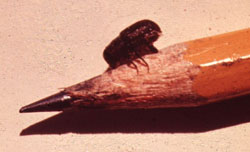The Silent Epidemic
The trouble didn’t start in Grand Lake, but it certainly found a home there. Grand Lake sits in the heart of the Rockies. The lake—along with the town that shares its name—is one of the most popular summer destinations in Colorado and has been for generations. If you stand on the shores, you catch an unencumbered view of Shadow Mountain, a majestic sentry that has guarded these waters since their glacial birth. But something is wrong with the mountain. Its slopes, rather than glimmering with the lively green of lodgepole pines, flash a wall of rust and gray, a sure sign of the trees” defeat.
Grand Lake lies in the path of an assault on forests across much of the western U.S. and Canada. As a result of drought, warmer temperatures and an abundance of mature growth, the trees that carpet the slopes over millions of acres are falling victim to unprecedented levels of infestation by the mountain pine beetle. In the area around Grand Lake, which includes the western half of Rocky Mountain National Park, experts predict that they could lose 80 to 90 percent of their lodgepole pines.
According to Sheryl Costello, an entomologist with the U.S. Forest Service, mountain pine beetles killed five million lodgepole pines in Colorado in 2006, up from one million in 2005. All together, that’s more than one million infested acres.
Beetle outbreaks are not uncommon in the West and “play an important role in recycling forests,” says Costello. But the extent and severity of the current outbreak exceeds anything in recent history. And now the beetles are moving into higher elevations, expanding their habitat and digging into tree species they’ve previously left alone.
Mountain pine beetles, bugs about the size of pumpkin seeds, carry out coordinated mass attacks on trees in the summer, when they tunnel beneath the bark to mate and lay eggs. When the eggs hatch, the larvae go on a feeding frenzy throughout the fall, rest in the winter, and feed more in the spring. By then, it’s too late for the tree, leading to the rusty, ashen landscape now in evidence at Grand Lake.
Until recently, Logan worked as an entomologist for the U.S. Forest Service. He first studied the mountain pine beetle in the early 1970s, but not until the 1990s did he grow concerned that beetle outbreaks might be more than just a natural phenomenon. With the release of an Intergovernmental Panel on Climate Change (IPCC) report, he and several colleagues began conducting research and developing models that they hoped would predict the impact of a warming climate on mountain pine beetle outbreaks. Their results were quite clear: the warmer it got, the more susceptible trees became.

Current trends support their findings. But Logan is not especially concerned about the lodgepole pines. Like Costello, he believes that mountain pine beetles play an important role in the forest ecology. “My grandchildren will see those forests come back,” says Logan. “It’s not a critical issue. Whitebark pine is a serious issue.”
Whitebark pines—those weather-weary sentinels at the upper reaches of treeline—stand up to the darkest, coldest and windiest of alpine winters. From Yellowstone to the Sierras, they stabilize rocks and soil on steep terrain, accumulate and retain snow, and extend the snowmelt to supply water into the growing season. Whitebark pines also provide an important food source to a number of animals, including the red squirrel and the grizzly bear.
It turns out that the grizzly’s survival is directly tied to the whitebark pine because the tree’s seed provides a high-fat food source in late summer and fall when other food is less abundant. And when bears are searching for pine nuts, they’re not scavenging at lower elevations, where they’re more likely to encounter humans.
Until recently, scientists considered the elevations where the pines grew too harsh for severe beetle attacks. The last major outbreak happened in the 1930s, one of the West’s warmest decades in recent history. “What happened in the 1930s was a warning to us,” Logan says, “and should have been taken more seriously.”
Logan sees the current beetle infestations as part of a trend that began in 1975, with no end in sight. And it’s a trend that’s heading north.
In 2005, mountain pine beetles infested nearly 23 million acres of lodgepole pines in western Canada. According to Allan Carroll, a research scientist with the Canadian Forest Service, “the current outbreak is unprecedented and outpaces the last one by 10 to one.” Carroll provides two reasons for this epidemic: global warming and the multitude of mature pines—the result of years of fire suppression and selective harvesting.
The collision of warmer temperatures with lots of big trees has created the perfect storm, and the beetles have now reached further north than ever before. They’ve even jumped the Continental Divide and spread northeast into the edges of the boreal forest, a swath of trees that stretches across Canada to the Eastern Seaboard.
Lodgepole pines don’t dominate the boreal forest, jack pines do. And the insects are making themselves right at home. “We know beetles can get into jack pines and kill them,” Carroll says, “but we don’t know the implications exactly. Will it wipe them out, kill only a few, follow the same pattern as the lodgepole?”
Carroll is trying to find answers before it’s too late. As the boreal forest continues to warm, the trees become more susceptible to invasion, making it possible for the beetles to find their way west toward Alaska and east toward the Atlantic. “Beetles are the canaries in the coal mine,” says Carroll.

